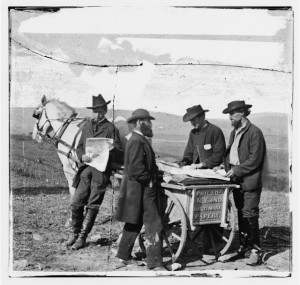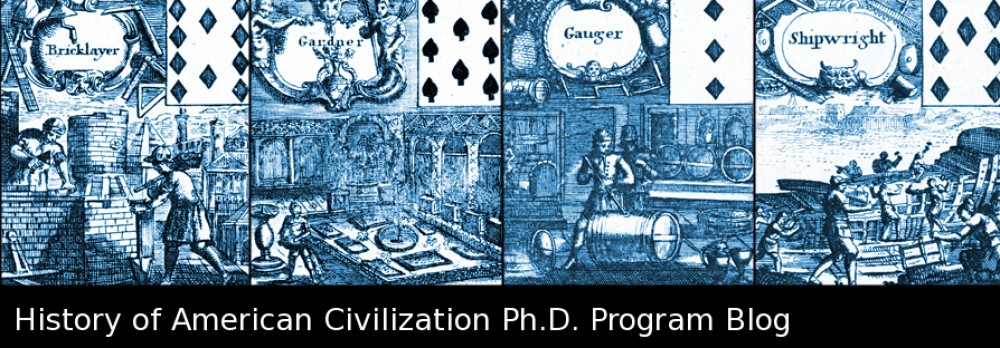
These Civil War-era men bought their news from a peddler with a horse and cart. My students need not look further than their laptops for early America in the news. Alexander Gardner, Newspaper Vendor and Cart in Virginia Camp, 1863 (Library of Congress)
History is not dead. At least, that’s what I hope to impart to my students through a weekly exercise I call “early America in the news.” Each Thursday before my students’ early American history Friday discussion sections, I receive an email from those who have signed up for that day to summarize and comment on one recent news story that features any aspect of American history through 1865. After I screen the story they have emailed to make sure it is, in fact, about American history up through the Civil War (there was some coaching involved in training them how to google such stories), I let them know it’s a keeper. Then, I prepare a few things to say about the story for class. The next day, we commence our discussion sections with the news story. Voila! Instant educational (not to mention topical) ice breaker.
Thus far, in addition to giving me a way to structure the beginning of most discussions, the exercise has, I think, accomplished a number of objectives. First, the assignment contributes toward the students’ participation grade. Therefore, it’s a low stakes but fun task that gets them talking about something they find interesting. I think I have even noticed some eye-twinkling while one student confessed his love of baseball in the course of telling the class about a baseball one African American orderly picked up after the Battle at Shiloh, Tennessee, in 1862 (in this case, the students even found one of my favorite history blogs, The Vault). I used this particular story to talk a bit about the significance of nationalizing experiences such as the Civil War, the consumption of mass-produced goods, and participation in “national” leisure activities such as going to the movies. It’s OK to talk about “modern” American history topics, of course, as that discussion links topics covered in 1865-to-the-present surveys that students tend to be more familiar with in the first place.
Lest you think this is all fun and games, in another class, a student brought in a story about an exhibition at the History Colorado Center featuring the Jefferson Bible. Thomas Jefferson (1743-1826), if you aren’t aware, cut and pasted together his version of The Bible that, in the words of Smithsonian curator Harry Rubenstein, excluded “anything [Jefferson] could not believe through the lens of reason.” When I asked the student why he found this particular story to be interesting, he said it shed light on Jefferson’s “private” side. He went on to explain that he didn’t feel that we necessarily get this perspective from the typical textbook or Friday discussion section. (For more nerdery, check out the slick web site the Smithsonian put together that all about TJ’s Bible.) And, hot dog, it was a great material culture embodiment of Jefferson’s Enlightenment perspective (however complicated TJ was in reality)! Since objects come up often in this assignment, it’s a good opportunity to discuss the advantages and disadvantages of various kinds of evidence, ranging from material culture to oral history to manuscript sources.
Other topics have ranged from editorials likening Alexander Hamilton et al.’s deft handling of the early Republic’s economic woes to the contemporary debate over America’s economic crisis to debates over whether the movie Lincoln did more to hurt or help history (I could have cited any number of essays here, as much ink has been spilled in the historical community on this topic!).
I could go on, but you have probably surmised the second objective by now: In addition to getting students excited about a specific aspect of history they find intriguing, the exercise reinforces history’s relevance to important contemporary political debates. Not only is history alive, but you can touch it, too.
I confess that this exercise is not a wholly original idea. I was inspired by the Junto: A Group Blog on Early American History’s weekly roundup of early America in the news blog postings (you can read the most recent one here), as well as Am Civ colleague Alison Kreitzer who assigned a similar task to her world history students last semester (thanks to both parties!). But if there are any other fledgeling educators out there looking for a simple class exercise that will get your students talking and thinking outside the survey box–and maybe even get them to a museum or to read the news more often–concocting your own version of this assignment might be a good start.
About the author: When she is not antiquing, hanging out in a museum, or teaching, Nicole Belolan is studying material culture and disability in early America. Read more about her work at her web site, http://www.nicolebelolan.org, and follow her on Twitter @nicolebelolan.

